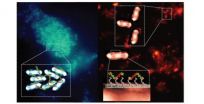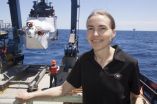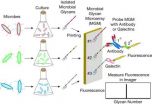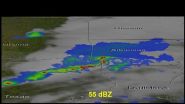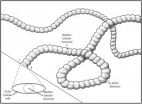(Press-News.org) VIDEO:
Dr. Nerlie Abram, from the Australian National University, explains why ocean winds have stopped Antarctica from warming as much as other continents. Her research also explains droughts in Southern Australia.
Click here for more information.
New Australian National University-led research has explained why Antarctica is not warming as much as other continents, and why southern Australia is recording more droughts.
Researchers have found rising levels of carbon dioxide in the atmosphere are strengthening the stormy Southern Ocean winds which deliver rain to southern Australia, but pushing them further south towards Antarctica.
Lead researcher Nerilie Abram, from the ANU Research School of Earth Sciences, said the findings explained the mystery over why Antarctica was not warming as much as the Arctic, and why Australia faces more droughts.
"With greenhouse warming, Antarctica is actually stealing more of Australia's rainfall. It's not good news – as greenhouse gases continue to rise we'll get fewer storms chased up into Australia," Dr Abram said.
"As the westerly winds are getting tighter they're actually trapping more of the cold air over Antarctica," Abram said. "This is why Antarctica has bucked the trend. Every other continent is warming, and the Arctic is warming fastest of anywhere on earth."
While most of Antarctica is remaining cold, rapid increases in summer ice melt, glacier retreat and ice shelf collapses are being observed in Antarctic Peninsula, where the stronger winds passing through Drake Passage are making the climate warm exceptionally quickly.
Until this study, published in Nature Climate Change, Antarctic climate observations were available only from the middle of last century.
By analysing ice cores from Antarctica, along with data from tree rings and lakes in South America, Dr Abram and her colleagues were able to extend the history of the westerly winds back over the last millennium.
"The Southern Ocean winds are now stronger than at any other time in the past 1,000 years," Abram said.
"The strengthening of these winds has been particularly prominent over the past 70 years, and by combining our observations with climate models we can clearly link this to rising greenhouse gas levels."
Study co-authors Dr Robert Mulvaney and Professor Matthew England said the study answered key questions about climate change in Antarctica.
"Strengthening of these westerly winds helps us to explain why large parts of the Antarctic continent are not yet showing evidence of climate warming," said Dr Mulvaney, from the British Antarctic Survey.
"This new research suggests that climate models do a good job of capturing how the westerly winds respond to increasing greenhouse gases," added Professor England, from the Climate Change Research Centre at UNSW.
"This isn't good news for farmers reliant on winter rainfall over the southern part of Australia."
INFORMATION: END
Ocean winds keep Antarctica cold, Australia dry
Why Antarctica isn't warming as much as other continents
2014-05-11
ELSE PRESS RELEASES FROM THIS DATE:
Hijacking bacteria's natural defences to trap and reveal pathogens
2014-05-11
The breakthrough, published in the journal Nature Materials, could offer an easier way of detecting pathogenic bacteria outside of a clinical setting and could be particularly important for the developing world, where access to more sophisticated laboratory techniques is often limited.
The research was led by Professor Cameron Alexander, Head of the Division of Drug Delivery and Tissue Engineering and EPSRC Leadership Fellow in the University's School of Pharmacy, building on work by PhD student Peter Magennis. Professor Alexander said: "Essentially, we have hijacked ...
UGA research examines fate of methane following the Deepwater Horizon spill
2014-05-11
Athens, Ga. – The 2010 Deepwater Horizon blowout discharged roughly five million gallons of oil and up to 500,000 tons of natural gas into Gulf of Mexico offshore waters over a period of 84 days. In the face of a seemingly insurmountable cleanup effort, many were relieved by reports following the disaster that naturally-occurring microbes had consumed much of the gas and oil.
Now, a team of researchers led by University of Georgia marine scientists have published a paper in the journal Nature Geoscience that questions this conclusion and provides evidence that microbes ...
Galectins direct immunity against bacteria that employ camouflage
2014-05-11
Our bodies produce a family of proteins that recognize and kill bacteria whose carbohydrate coatings resemble those of our own cells too closely, scientists have discovered.
Called galectins, these proteins recognize carbohydrates from a broad range of disease-causing bacteria, and could potentially be deployed as antibiotics to treat certain infections. The results are scheduled for publication in Nature Chemical Biology.
Researchers at Emory University School of Medicine made the discovery with the aid of glass slides coated with an array of over 300 different glycans ...
Study finds patients AFib at higher risk of dementia when meds out of range
2014-05-10
A new study by researchers at the Intermountain Medical Center Heart Institute in Salt Lake City has found that atrial fibrillation patients who are on blood thinning medications are at higher risk of developing dementia if their doses are not in the optimal recommended range.
The study of more than 2,600 AFib patients found they are significantly more likely to develop dementia when using medicines to prevent blood clots, such as warfarin, when their dosing is too high or too low for an extended period of time.
Findings from the study will be presented at the 2014 ...
Bee biodiversity boosts crop yields
2014-05-10
Research from North Carolina State University shows that blueberries produce more seeds and larger berries if they are visited by more diverse bee species, allowing farmers to harvest significantly more pounds of fruit per acre.
"We wanted to understand the functional role of diversity," says Dr. Hannah Burrack, an associate professor of entomology at NC State and co-author of a paper on the research. "And we found that there is a quantifiable benefit of having a lot of different types of bees pollinating a crop."
The researchers looked at blueberries in North Carolina ...
Scientists find gene behind a highly prevalent facial anomaly
2014-05-10
CAMBRIDGE, Mass. (May 9, 2014) – Whitehead Institute scientists have identified a genetic cause of a facial disorder known as hemifacial microsomia (HFM). The researchers find that duplication of the gene OTX2 induces HFM, the second-most common facial anomaly after cleft lip and palate.
HFM affects approximately one in 3,500 births. While some cases appear to run in families, no gene had been found to be causative. That is until Whitehead Fellow Yaniv Erlich and his lab set out to do just that. Their work is described in this week's issue of the journal PLOS ONE.
Patients ...
Cardiac screening test may help determine who should take aspirin to prevent heart attack
2014-05-09
MINNEAPOLIS, MN – May 6, 2014 – For over 30 years, aspirin has been known to prevent heart attacks and strokes, but who exactly should take a daily aspirin remains unclear. New research published today in Circulation: Cardiovascular Quality and Outcomes shows that your coronary artery calcium (CAC) score, a measurement of plaque in the arteries that feed the heart, may help determine whether or not you are a good candidate for aspirin.
"Many heart attacks and strokes occur in individuals who do not appear to be at high risk," states lead author, Michael D Miedema, MD, ...
NASA's TRMM Satellite see spring storms hit the US Great Plains
2014-05-09
VIDEO:
The TRMM satellite flew above tornado spawning thunderstorms in the southern United States on May 9, 2014 at 0115 UTC. This simulated 3-D TRMM animation shows the location of intense...
Click here for more information.
The Tropical Rainfall Measuring Mission or TRMM satellite captured rainfall and cloud height information about the powerful thunderstorms and severe weather that affected the Great Plains over May 8 and 9.
Severe weather extended from Minnesota to southern ...
Plugging leaky blood vessels to save vision
2014-05-09
TORONTO – A new drug approach has been developed for safer clean-up of deformed blood vessels in the eye by a research team at the Lunenfeld-Tanenbaum Research Institute, Mount Sinai Hospital in Toronto.
The growth of malformed blood vessels that can burst is a leading cause of vision loss in North America. Retinopathy and retina degeneration are associated with premature birth, with diabetes, and with increasing age.
Research just published by Dr. Andras Nagy and co-authors shows both safety and effectiveness in their bioengineered compound when treating retinopathy ...
Paleontologists discover new fossil organism
2014-05-09
RIVERSIDE, Calif. — Scientists at the University of California, Riverside have discovered a fossil of a newly discovered organism from the "Ediacara Biota" — a group of organisms that occurred in the Ediacaran period of geologic time.
Named Plexus ricei and resembling a curving tube, the organism resided on the Ediacaran seafloor. Plexus ricei individuals ranged in size from 5 to 80 centimeters long and 5 to 20 millimeters wide. Along with the rest of the Ediacara Biota, it evolved around 575 million years ago and disappeared from the fossil record around 540 million ...
LAST 30 PRESS RELEASES:
Air pollution exposure and birth weight
Obstructive sleep apnea risk and mental health conditions among older adults
How talking slows eye movements behind the wheel
The Ceramic Society of Japan’s Oxoate Ceramics Research Association launches new international book project
Heart-brain connection: international study reveals the role of the vagus nerve in keeping the heart young
Researchers identify Rb1 as a predictive biomarker for a new therapeutic strategy in some breast cancers
Survey reveals ethical gaps slowing AI adoption in pediatric surgery
Stimulant ADHD medications work differently than thought
AI overestimates how smart people are, according to HSE economists
HSE researchers create genome-wide map of quadruplexes
Scientists boost cell "powerhouses" to burn more calories
Automatic label checking: The missing step in making reliable medical AI
Low daily alcohol intake linked to 50% heightened mouth cancer risk in India
American Meteorological Society announces Rick Spinrad as 2026 President-Elect
Biomass-based carbon capture spotlighted in newly released global climate webinar recording
Illuminating invisible nano pollutants: advanced bioimaging tracks the full journey of emerging nanoscale contaminants in living systems
How does age affect recovery from spinal cord injury?
Novel AI tool offers prognosis for patients with head and neck cancer
Fathers’ microplastic exposure tied to their children’s metabolic problems
Research validates laboratory model for studying high-grade serous ovarian cancer
SIR 2026 delivers transformative breakthroughs in minimally invasive medicine to improve patient care
Stem Cell Reports most downloaded papers of 2025 highlight the breadth and impact of stem cell research
Oxford-led study estimates NHS spends around 3% of its primary and secondary care budget on the health impacts of heat and cold in England
A researcher’s long quest leads to a smart composite breakthrough
Urban wild bees act as “microbial sensors” of city health.
New study finds where you live affects recovery after a hip fracture
Forecasting the impact of fully automated vehicle adoption on US road traffic injuries
Alcohol-related hospitalizations from 2016 to 2022
Semaglutide and hospitalizations in patients with obesity and established cardiovascular disease
Researchers ‘listen in’ to embryo-mother interactions during implantation using a culture system replicating the womb lining
[Press-News.org] Ocean winds keep Antarctica cold, Australia dryWhy Antarctica isn't warming as much as other continents



